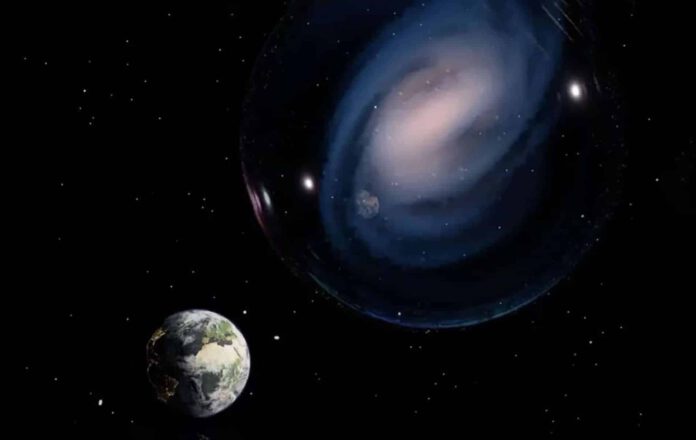
Researchers employing the James Webb Space Telescope have succeeded in discovering the most distant bar spiral galaxy known to exist. To the surprise of the research team, this finding challenges our current understanding of how galaxies form and evolve.
Our Milky Way: A Bar Spiral Galaxy
Our Milky Way belongs to the class of bar spiral galaxies. Salient to this type of galaxy is an ellipsoid bar-like structure running through the center of the disk-like spiral galaxy. Around this bar, spiral arms, populated by stars, unfurl. It was a widely held belief that bar spiral galaxies like the Milky Way did not exist until the Universe had reached approximately half of its current age of 13.8 billion years. However, a new discovery reported in the esteemed Nature journal is shaking the foundations of that assumption.
The Discovery of ceers-2112
Astronomers peering into the night sky with the powerful James Webb Telescope made a stunning discovery. They found the most distant bar spiral galaxy that has been observed to this point. This galaxy looked surprisingly ‘developed’ for its age. According to the researchers, the newly discovered galaxy could be considered a sibling of our own Milky Way. “The galaxy in question, called ceers-2112, formed shortly after the Big Bang,” explains co-author Alexander de la Vega. “The discovery of this galaxy suggests that galaxies in the early universe could be just as organized as our Milky Way. This is surprising because galaxies during that early period were much more chaotic. Furthermore, they had very few structures comparable to those of the Milky Way.”
The Central Bar of ceers-2112
Particularly remarkable is the fact that ceers-2112 has a central bar. “A galactic bar is a structure comprised of stars inside a galaxy,” reveals de la Vega. “These bars resemble objects we encounter in everyday life, such as a granola bar.” While it is possible to find bars in galaxies that lack a spiral structure, they are quite rare. “Bars are usually found in spiral galaxies,” observes De la Vega.
The Rotation and Formation of Bars
So, how do galactic bars actually form in spiral galaxies? It is generally accepted that bars form in systems where the stars rotate in an orderly manner, as happens in our Milky Way. “In such galaxies, bars can naturally arise due to instability in the spiral structure or the gravitational effects of neighbouring galaxies,” de la Vega explains. “As mentioned earlier, we know that in the distant past, when the Universe was very youthful, galaxies were unstable and chaotic. It was then supposed that bars could not form in that early universe—or at least could not last for an extended period.”
An Organized Galaxy in the Youthful Universe
Finding this ‘second Milky Way’ in the young Universe is indeed very special. The discovery of this distant galaxy suggests that certain processes in the early Universe differed from our previous assumptions, affecting our overall understanding of how galaxies form and evolve. Astronomers used to believe that it would take several billion years for galaxies to become sufficiently organized to form bars. But the discovery of ceers-2112 shows that this can apparently occur within only a fraction of that time, in about one billion years, or even less. “The presence of a bar in ceers-2112 suggests that galaxies possibly matured more quickly and organized themselves over a shorter timeframe than was previously assumed,” De la Vega says. “This implies that some aspects of our theories about how galaxies form and evolve must be revised.”
Updating Theoretical Models
The discovery of ceers-2112 is set to cause at least two significant shifts in the field of astronomy. “In the first place, the theoretical models that describe the formation and evolution of galaxies now need to take into account that some galaxies could have been stable enough to develop bars early on in the history of the universe,” De la Vega emphasizes. “These theoretical models may need to reconsider how much dark matter is involved in the formation of galaxies in the early universe, as dark matter is assumed to affect the speed at which bars form. Secondly, the discovery of ceers-2112 reveals that structures such as bars can be detected in the very young Universe. This is significant because galaxies in the remote past were smaller than they are today, which generally makes it more difficult to detect bars. The discovery of ceers-2112 thus opens the door to the detection of more bars in the young Universe.”
A Surprising Degree of Precision
What most surprised De la Vega about the discovery of ceers-2112 was the accuracy and detail with which the properties of the bar could be determined. “I thought that the detection and estimation of the properties of bars in galaxies like ceers-2112 would likely involve significant measurement uncertainties,” the researcher admits. “But thanks to the power of the James Webb Space Telescope and the expertise of our research team, we were able to map the size and shape of the bar very accurately.” This discovery underlines the undeniable value of the Webb Telescope once more.











